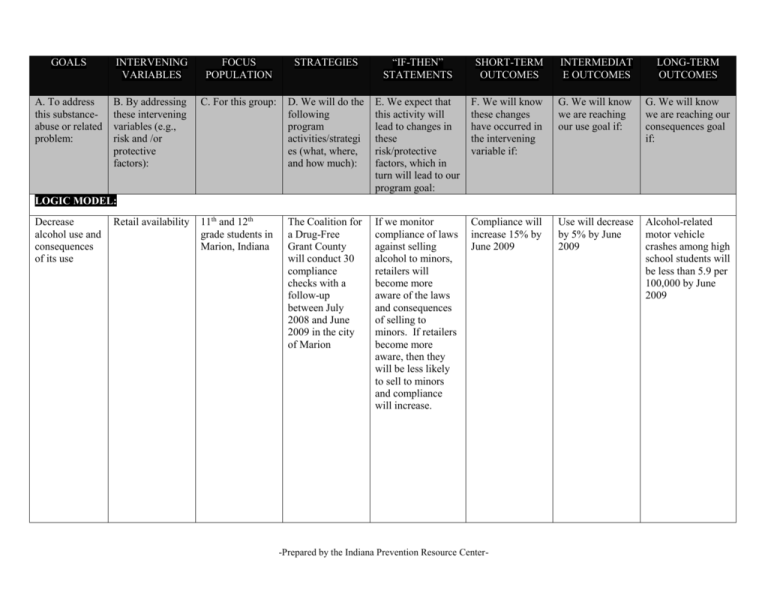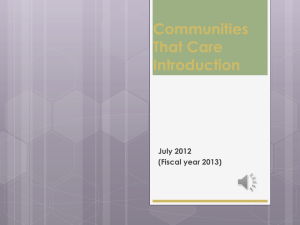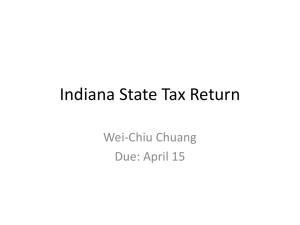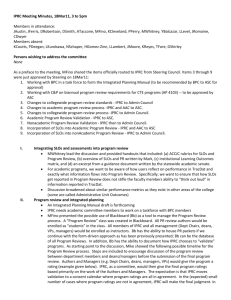Sample Evaluation Plan #2 - Indiana Prevention Resource Center
advertisement

GOALS INTERVENING VARIABLES FOCUS POPULATION STRATEGIES “IF-THEN” STATEMENTS SHORT-TERM OUTCOMES INTERMEDIAT E OUTCOMES LONG-TERM OUTCOMES A. To address this substanceabuse or related problem: B. By addressing these intervening variables (e.g., risk and /or protective factors): C. For this group: D. We will do the following program activities/strategi es (what, where, and how much): E. We expect that this activity will lead to changes in these risk/protective factors, which in turn will lead to our program goal: F. We will know these changes have occurred in the intervening variable if: G. We will know we are reaching our use goal if: G. We will know we are reaching our consequences goal if: 11th and 12th grade students in Marion, Indiana The Coalition for a Drug-Free Grant County will conduct 30 compliance checks with a follow-up between July 2008 and June 2009 in the city of Marion If we monitor compliance of laws against selling alcohol to minors, retailers will become more aware of the laws and consequences of selling to minors. If retailers become more aware, then they will be less likely to sell to minors and compliance will increase. Compliance will increase 15% by June 2009 Use will decrease by 5% by June 2009 Alcohol-related motor vehicle crashes among high school students will be less than 5.9 per 100,000 by June 2009 LOGIC MODEL: Decrease alcohol use and consequences of its use Retail availability -Prepared by the Indiana Prevention Resource Center- EVALUATION QUESTIONS: GOALS To what extent was alcohol use and alcoholrelated motor vehicle crashes among high school students reduced in the target population? INTERVENING VARIABLES To what extent was retail availability reduced in the target population? FOCUS POPULATION How many 11th and 12th graders live in Marion, Indiana? STRATEGIES “IF-THEN” STATEMENTS Were 30 compliance checks completed in Marion between July 2008 and June 2009? To what extent were retailers aware of the laws and consequences of selling alcohol to minors? To what extent were retailers willing to sell alcohol to minors in the future? STRATEGIES “IF-THEN” STATEMENTS SHORT-TERM OUTCOMES Retailer survey (Indiana code followed by rating of awareness and likelihood of future sales to minors) Compliance rate determined from activity log SHORT-TERM OUTCOMES To what extent did compliance improve? INTERMEDIAT E OUTCOMES To what extent did past month alcohol use decrease among 11th and 12th graders? LONG-TERM OUTCOMES To what extent did alcohol-related motor vehicle crashes among high school students decrease? METHODS: GOALS Use – 2009 Marion High School results from the IPRC Indiana Survey monthly use of alcohol items (11th – 12th graders) Consequences – FARS INTERVENING VARIABLES Item 18 IPRC Indiana Survey (During the past month, how did you usually get your alcohol?) FOCUS POPULATION Prev Stat report from IPRC Count from activity log (Date, location, compliant/noncompliant) -Prepared by the Indiana Prevention Resource Center- INTERMEDIAT E OUTCOMES IPRC Indiana Survey LONG-TERM OUTCOMES FARS GOALS INTERVENING VARIABLES FOCUS POPULATION STRATEGIES “IF-THEN” STATEMENTS SHORT-TERM OUTCOMES INTERMEDIAT E OUTCOMES LONG-TERM OUTCOMES A. To address this substanceabuse or related problem: B. By addressing these intervening variables (e.g., risk and /or protective factors): C. For this group: D. We will do the following program activities/strategi es (what, where, and how much): E. We expect that this activity will lead to changes in these risk/protective factors, which in turn will lead to our program goal: F. We will know these changes have occurred in the intervening variable if: G. We will know we are reaching our use goal if: G. We will know we are reaching our consequences goal if: Parents of high school children in Marion, Indiana recruited from PTO, churches, and social/civic clubs A monthly parent forum will be held (July 2008June 2009) to educate parents of the problem of alcohol use among youth and strategies they can do to prevent use If we organize a parent forum, parents will become more aware of the problem of youth drinking and its consequences. If parents are more aware, they will be more likely to become involved in prevention efforts in the community Parents’ awareness of alcohol use and consequences among youth will increase by 25% by June 2009 Parents participating in forums will report a 25% increase in involvement in prevention efforts in the community by June 2009 Community awareness of alcohol use and consequences among youth will increase by 25% by June 2009 LOGIC MODEL: Increase prevention infrastructure and capacity Increase community awareness of alcohol use and consequences among youth in Grant County -Prepared by the Indiana Prevention Resource Center- EVALUATION QUESTIONS: GOALS To what extent was prevention infrastructure and capacity increased? INTERVENING VARIABLES To what extent was community awareness of alcohol use and consequences among youth increased? FOCUS POPULATION How parents of high school students reside in Marion? STRATEGIES Was a monthly parent forum held? “IF-THEN” STATEMENTS To what extent did parents participate in the forum? To what extent was parents’ awareness increased? To what extent were parents more likely to participate in prevention efforts? SHORT-TERM OUTCOMES INTERMEDIAT E OUTCOMES LONG-TERM OUTCOMES To what extent did parents’ participation in prevention efforts increase? To what extent did community awareness increase? SHORT-TERM OUTCOMES INTERMEDIAT E OUTCOMES LONG-TERM OUTCOMES Goodman and Wandersman community readiness survey (personal concern about AOD items) Goodman and Wandersman community readiness survey (personal increased involvement items) To what extent did parents’ awareness increase? METHODS: GOALS CLI Part I items 75-80 (July 2008 responses compared to July 2009 responses) INTERVENING VARIABLES Goodman and Wandersman community readiness survey FOCUS POPULATION Prev Stat report from IPRC STRATEGIES Activity log (Date, location, attendance) “IF-THEN” STATEMENTS Activity log, Goodman and Wandersman community readiness survey (pre/post) -Prepared by the Indiana Prevention Resource Center- Goodman and Wandersman community readiness survey results from epi profile year 1 and year 2 Evaluation Plan Guidance Document This document describes the key elements in the Evaluation Plan that will be included as part of the strategic plan. Each section describes the information that should be included in each section followed by an example. Element 1: Logic Model and Overview Each evaluation plan should include a logic model detailing the goals set forth by CSAP (decrease use, consequences of use, and increase prevention infrastructure/capacity), intervening variable(s) and focus population (determined by the epi profile), strategies chosen to address the intervening variable(s), if-then statements outlining the sequence of events, short-term outcomes related to intervening variable(s), intermediate outcomes related to use, and long-term outcomes related to consequences of use. At minimum, there should be a separate logic model for each goal. Element 2: Evaluation Questions and Methods Evaluation questions help determine to what extent each element of the logic model was performed or achieved. Questions should correspond to each goal, variable, focus population, etc. For additional information about evaluation questions, see the SAPST Participant’s Manual (section 4). Evaluation questions must be measurable. Methods for measurement must be identified for each question. When possible, use sources of data that are required or readily available rather than superfluous, lengthy or obtrusive measures. Element 3: Data Collection, Management, and Analysis The data collection section should identify how each piece of data will be collected, at what frequency, and by whom. Data management and analysis will address the operational steps in data collection which are data entry, how data is stored, analyzed and by whom. For instance, allocate the duties of raw data entry into Excel files to a specific staff member. Thereafter, data analysis may be performed by a capable staff or workgroup member or assistance may be sought from the IPRC Evaluation Team. Also, analysis could be performed on SPSS through the IPRC remote access. Depending upon the specific results and community needs, SPSS will generate a variety of analysis such as prevalence, frequency, or comparisons. Thorough consultation with the evaluation workgroup and IPRC staff will determine the appropriate statistical analysis approach. Element 4: Interpretation and Reporting Concise and systematic interpretation and reporting of program evaluation results will ensure accountability and guide future program development. In collaboration with the evaluation workgroup and the IPRC staff, interpretation of statistical results will provide the framework to construct an evidence-based report. This report should be shared with stakeholders and DMHA. -Prepared by the Indiana Prevention Resource Center- Grant County SPF SIG Evaluation Plan The Grant County SPF SIG Coalition will implement an evidence-based environmental alcohol prevention intervention in Marion to address CSAP goals of reducing use of alcohol and alcohol-related motor vehicle crashes (consequences of use) through the reduction of retail availability of alcohol to minors. Retail availability was identified in the epi profile as a variable contributing to underage drinking in Grant County. Specifically, a high percentage of minors reported purchasing liquor from retail outlets. No other interventions address retail availability in Grant County. The intervention will focus on 11th and 12th grade students in Marion – the group with the highest rates of obtaining alcohol in retail outlets according to IPRC’s Indiana Survey. Evidence supports the effectiveness of retail outlet compliance checks on alcohol availability (Scribner & Cohen, 2001), thus the intervention will consist of compliance checks in the city of Marion. Overall, it is expected that compliance checks will increase awareness of alcohol laws among retailers and decrease the likelihood of sales to minors. Short-Term Outcome Objective - According to the 2007 Indiana Survey of Alcohol Compliance, 68% of Indiana retailers were compliant. Scribner & Cohen (2001) found a 28.7% increase in compliance after compliance checks. Therefore, it is expected that compliance will increase 15% by June 2009 (as measured by compliance rate determined from activity log). Intermediate Outcome Objective – According to the IPRC Indiana Survey 34.3% of 11th graders and 35.7% of 12th graders in the East region reported using alcohol in the past month. It is expected that use among Marion high school juniors and seniors will decrease by 5% to 29.3% and 30.7%, respectively (as measured by the 2009 IPRC Indiana Survey). Long-Term Outcome Objective - Alcohol-related motor vehicle crashes among high school students will be less than 5.9 per 100,000 (HP2010 Objective 26-1a) (as measured by FARS). Activity logs will be completed by youth conducting compliance checks. Data will be entered and compliance rates calculated by the Program Assistant. Marion Community Schools has agreed to participate in the IPRC Indiana Survey in 2009 and will provide a copy of the report to the Program Director. FARS data will be obtained from the Indiana Prevention Resource Center’s PrevStat. CSAP has an additional goal of SPF SIG to increase prevention infrastructure and capacity. According to the CLI Part I (Items 69-159), community awareness is a component of capacity building. A community readiness survey conducted in Year 1 revealed low community readiness in the areas of personal concern about AOD and involvement in prevention activities. Thus, the Grant County SPF SIG Coalition will increase prevention infrastructure/capacity through raising parents’ awareness of alcohol use among minors and the consequences of its use. This will be accomplished through a monthly parent forum to educate parents of the problem of alcohol use among youth and strategies they can do to prevent use based on Take it Back (faceproject.org). Overall, it is expected that parent forums will increase parents’ awareness of the problem of youth drinking and its consequences, which will increase parent involvement in prevention efforts in the community. Short-Term Outcome Objective - Parents’ awareness of alcohol use and consequences among youth will increase by 25% (as measured by Goodman and Wandersman community readiness personal concern about AOD survey items). Intermediate Outcome Objective – Parents participating in forums will report 25% more involvement in prevention efforts in the community (as measured by Goodman and Wandersman community readiness personal increased involvement survey items). Long-Term Outcome Objective - Community awareness of alcohol use and consequences among youth will increase by 25% (as measured by Goodman and Wandersman community readiness survey results from epi profile year 1 and year 2). Community readiness surveys will be administered to parents in a pre/post fashion using IPRC’s online survey access. The survey will also be administered to the wider community once per year. Results will be recorded on the quarterly benchmark report by the Program Director and Assistant, then compiled by the Evaluation Workgroup with the assistance of the IPRC Evaluation Team into an evaluation report by June 30, 2009 and presented to the LAC. -Prepared by the Indiana Prevention Resource Center-







